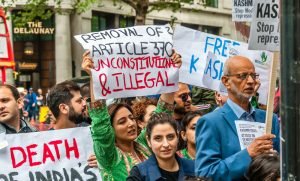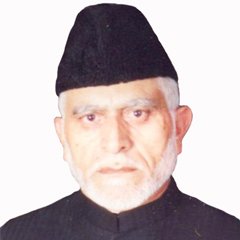The petitions, to be taken up by a five-judge bench headed by Chief Justice of India DY Chandrachud, will be heard almost four years after the Indian government reconstituted the state of Jammu and Kashmir into the two ‘union territories’ of J&K and Ladakh in August 2019.
With this act, the Indian government unilaterally stripped Kashmiris of the special autonomy they had enjoyed for seven decades through a rushed presidential order.
A leaf from history
Though the SCI has delivered several judgements relating to Article 370, two leading cases — Prem Nath Koul vs State of Jammu & Kashmir (1959 SCJ 797) and Sampat Parkash vs State of J&K ( AIR-1970 1118) — each heard by five member constitution benches, have extensively deliberated the law and accorded permanency to it.
As per practice and the procedure of the SCI, it would require a larger bench to overrule the earlier views of the five judges benches. If, prima facie, the SCI feels that the earlier views require review, the number of judges hearing the current petitions would have to be increased.
Moreover, the present bunch of cases involves extraordinary points requiring an in-depth exploration of the constitutional history, relating to the accession of the ruler with the union, compared to that undertaken in the earlier cases.
In exploring the constitutional history, the court will have to ensure it brings on record and examines the following documents and anecdotes from history:
- Indian Independence Act 1947;
- The Government of India Act, 1935, as adopted on August 15, 1947, by India;
- Letter of the Maharaja of the state to the Governor-General of India dated Oct 26, accompanied by the instrument of accession and its response by the Governor-General dated Oct 27, 1947;
- Parliamentary debates on Article 306 (re-numbered as Article 370);
- Speeches of former prime minister Jawaharlal Nehru and former president Ramaswamy Venkataraman inside parliament and outside;
- Speech of former J&K prime minister Sheikh Muhammad Abdullah in its constituent assembly;
- Various provisions of the Indian and J&K constitution, besides an honest appraisal of the circumstances that lead to militancy and the collapse of democratic institutions in Kashmir
For that matter, the court also cannot ignore the overall circumstances and environment which created a dispute between India and Pakistan, landing the subcontinent into trouble.
Promises, promises
At the time of Independence, the Maharaja of the Jammu and Kashmir, Hari Singh, was the only ruler out of all the princely states, who faced a people’s movement for self-rule. He alone, to his credit, negotiated the terms and conditions of accession with the union of India, that too against the ground realities. In doing so, the Maharaja was lucky enough to gain the support of his arch-rival, Sheikh Muhammad Abdullah, to support his decision of accession to India against the latter’s own constituency.
Maharaja Hari Singh managed the Delhi agreement of 1952 (signed by Sheikh Abdullah on behalf of government of J&K) between two popular governments of Delhi and Srinagar. Thus, the official record of the state, the ruler and the political leader’s statements cannot be brushed aside.
At the same time, looking from a broader perspective, the court cannot lose sight of the fact that 45 per cent of the land mass of the state, with over 1.3 million state subjects in AJK, GB, as well as those settled out of state, equally await the day to decide their destiny in accordance with the Independence Act 1947, the Government of India Act 1935, the Governor-General of India’s conditional acceptance of the instrument of accession, as well commitments of Indian leaders and the UN resolutions.
It can also not ignore the fact that the people of the parts of the state administered by Pakistan (on which India also asserts its claim) had resolved through a declaration by its government on Oct 24, 1947, (much before the ruler of the state had conditionally acceded to India), requesting the governments of India and Pakistan to help them decide their fate through a free and fair plebiscite. Article 257 of the Constitution of Pakistan pledges its support for the resolution.

A similar pledge was given by the Governor-General of India on Oct 27, 1947, in his letter to the Maharaja, which reads: “… as soon as law and order have been restored in Kashmir and her soil cleared of the invaders, the question of state’s accession should be settled by reference to the people …” This was endorsed by Mahatma Ghandhi and Jawaharlal Nehru as well as other stalwarts of the Indian freedom movement.
The same pledge was also endorsed by the United Nations Commission for India and Pakistan (UNCIP) through its resolution on Jan 5, 1949, after India had itself moved the UN Security Council on Jan 1, 1948. The Simla agreement of 1972 equally endorses the spirit of all of the above.
The Government of India is bound under Article 51 of its constitution “ … to foster respect for international law and treaty obligations“ and Article 253 “… for implementing any treaty, agreement or convention … made at any international conference, association or other body”.
The conditional accession by the Maharaja and its acceptance by the governor-general, irrespective of its legitimacy and propriety, was accorded approval by the union of India in the spirit of Article 2 of its constitution ‘subject to terms and conditions’ proposed by the ruler, guaranteed by Article 370.

The court cannot also ignore the contents of Articles 371-A to 371-I of the constitution, relating to other Indian states and union territories that enjoy the special status with almost similar rights (some even more). Although the latter had unconditionally acceded to India, they were given the guarantees due to their ground realities.
There is nothing novel in Article 370 that does not find a place in the above-mentioned special articles. But they are sacred because they are not for Jammu & Kashmir.
The fateful orders of August 5, 2019, are a blot on the constitution, which threaten to destroy the basic structure of the union of India. Through the presidential order, the state assembly was dissolved, the state was placed under union bureaucracy, controlled by around a million soldiers under union rule.
An employee of the union government is governing the state as its governor, who has to be construed and read under the presidential order as the ‘government’ and ‘Sadr-e-Riasat’. The legislative assembly is to be construed as the constituent assembly. In other words, the union is consulted by the union and consented by the union.
Interpreting the law
Article 370 is a condensed constitution in itself with its own mechanism of legislative process without the need for intervention from parliament. The terminology used in it is self-explanatory and does not leave room for any ambiguity.
The unequivocal words used in Article 370 cannot be subjected to subjective and whimsical interpretations, added through Article 367 of the constitution to give leverage to executive interpretations over the judicial power of interpretation.
Interpretation involves understanding, explaining and applying the meaning of laws, texts, or other sources of information that may be susceptible to different meanings.
It is an essential aspect of legal process, which is the prerogative of courts, legal professionals, jurists and scholars of relevant fields, who apply and interpret the law, and not the legislature or executive that only provide the foundations of law. Its application may vary from time to time with the change of facts, circumstances or environment.
Through its actions in August 2019, the Government of India has preempted the authority of its supreme court.
The words used in Article 370 are very clear. They mean what they say. Even if any ambiguity arises or there are mitigating circumstances that necessitated the Article have changed, the Article can be interpreted to meet the eventuality, but it cannot be made redundant by any branch of the state.
Interpretation reflects the mind of framers of the constitution or law, as well as the circumstances under which it was framed. Its intents and meanings can be ascertained from India’s library records as well as the constituent assembly’s debates (India as well as Kashmir), if the court finds any ambiguity.
The final word on interpretation of the constitution and law rests with the Supreme Court of India, not with the Indian government or parliament to say what a particular Article, clause or any word used therein means or to be construed as was done through the order on August 5, 2019.
Revisiting Article 370. (Part II)
In a significant turn of events, the Supreme Court of India has set the stage for a pivotal hearing of all cases against abrogation of Article 370 of the Constitution , just two days before its fourth anniversary . The date for the hearing is to begin from 2nd August 2023 and is expected to be conducted on consecutive days, except during miscellaneous matters.
The petitions before the court challenge the constitutional validity of the actions taken on 5th and 6th August 2019, followed by the enactment of The Jammu and Kashmir State Reorganisation Act, 201
The court rejected the affidavit of the Union of India, which presented post-notifications developments in the state, and objected to the relief sought, citing concerns about the security and sovereignty of India due to the peculiar geographical situation.
The court right narrowed down the proposition to the constitutional validity of the actions taken on August 5 & 6, 2019, followed by the Reorganisation of State Act 2019.
Protecting and Preserving the security and sovereignty of India is the responsibility of the union government , while protecting the spirit and structure of the constitution is duty of court .
The focal point before the court would be testing the impugned orders on the touch stone of constitution prevalent on 5th August 2019 and constitutional practice before that .
It is undisputed that , the Constituent Assembly of state stood dissolved in 1956, and the Legislative Assembly stands dissolved in 2018. Part vi of Indian constitution , regulating states does not apply to state of Jammu and Kashmir which is governed by its own constitution of 1956 which was in force on the fateful days but there was no popular elected government as defined under section 35(2) of the state constitution to be consulted or to consent to any amendment in Article 370, extending any provision of the Indian constitution with whatsoever modifications, exceptions or interpretations , like Article 367 , impugned before the court , as the state was under the rule of governor , effectively under union government.
All constitutional matters concerning the state of J&K are governed and regulated by Article 370 in the background of the “Instrument of Accession”. provisions of the constitution of India extended to the state through this article by the President of India, with consultation or concurrence, as the case may be, of the state Government. The state Government definitely does not mean Union Government.
The state was admitted into the union by the parliament, subject to the special conditions regulated by Article 370 under the authority of Article 2 of the constitution, which gives the parliament complete discretion to confer any status on the formed state. This article has an overriding effect on the entire constitution of India, which opens with the words, “Notwithstanding anything in this constitution.”
Article 3 of the Indian constitution, despite providing a stringent process for allowing the parliament to increase or diminish the area of any state, alter boundaries, or names of existing states, is subjected to even more stringent provisions when applied to the state of Jammu & Kashmir. It mandates that , “NO bill proposing such changes shall be introduced in parliament without the consent of the state’s legislature.” No authority including Parliament, can substitute itself for state legislature . It would be killing the federating unit , which is edifice of the relations between state and union.
The impugned order dated 5th August, issued under Article 370, introduced definitions that amended Article 367 of the constitution of India, assigning prevaricated meanings to different terms, such as “legislative Assembly” for “constituent Assembly” and “Governor” for the “Government of state.” These changes were contradictory to Article 370 and were followed by the abrogation of Article 370 through the presidential order dated 6th August and the Reorganisation of the state Act 2019, bifurcating and downgrading the state into two Union Territories governed by Lt. Governor .
These actions are, on their face, against Articles 2 and 3 of the constitution of India.
Article 370 is a special feature of federalism in the Indian constitution in relation to state of Jammu and Kashmir through which the state is integrated as Indian territory and as an Indian state. It also allows for the extension of the constitution of India to the state while allowing the federating unit to have its own constitution for governing internal state matters. This concept has been recognized as one of the 20 “basic structures/features” of the constitution by the Supreme Court of India in various cases, most notably in the landmark Keshavananda Bharti v. State of Kerala (1973) case.
Sub-articles 2 & 3 of Article 306A (renumbered as 370) respectively provide a comprehensive procedure for the application of the Indian constitution to the state and the abrogation of this article as a whole or its modification or application with exceptions. Every word of this article was meticulously discussed, drafted, and redrafted in the Constituent Assembly by the architects of the constitution from May to Oct. 1949, considering the sensitivity of its accession to India with its unique demographic composition and geographical contiguity despite a more suitable option otherwise , under partition plan of India .
This article was the only one out of the longest constitutions of the world , applied to the state under the authority of the Constituent Assembly of India on 26th of January 1950, leading the way for the state to be included in the territories of India under Article 1 on the same day. The fundamental and basic structure of this article cannot be emasculated.
Despite being part of the Indian constitution, Article 370 cannot be amended by the parliament of India under Article 368, which regulates the procedure for amending the constitution. Instead, this article provides its own mechanism for amendment through the procedure provided within the constitution itself under sub-article (3). It grants the President the power ——- “ to declare that Article 370 shall cease to be operative or shall be operative only with exceptions and modifications and from a specific date, provided the recommendation of the Constituent Assembly of the State referred to in clause (2) is necessary before the President issues such a notification.”
Additionally, the relationship between the center and the state has evolved over time by negotiations and practice , despite the aspirations of the people of the state surpassing the confines of Article 370.

Article 370 is out come of negotiations in constituent Assembly of India based on instrument of accession, followed by agreements of 1952 and 1975 between the state and union leadership .
Nations with integrity , honour and strengthen their commitments. Despite betrayals on different occasions , the special rights enjoyed by state for more than one hundred seventy five years under Article 35A were never trampled. Instead nine other Indian states were given almost similar special rights from time to time , although they had unconditionally acceded to India .
It is now essential to reconcile the past with the present while ensuring that all actions adhere to the principles of constitutionality, propriety, legitimacy, and the commitments made to the state over a course of seventy-five years relationship .
In conclusion, the upcoming hearing presents an opportunity to redefine the contours of federalism , address the balance between federalism, the power of parliament, and the special guarantees of Article 370 in the context of the evolving aspirations of the people of Jammu and Kashmir and the broader interests of Indian polity.
(The author is former chief justice of the Azad Jammu and Kashmir Supreme Court.)

